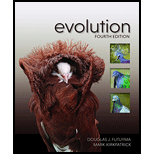
Concept explainers
To explain: Whether clades with few living species may be very young.
Introduction: A group of organisms that have been originated and evolved from one common ancestor is called a clade. The variation occurred due to the evolution of a common ancestor to adapt and diversify into one or more species and subgroups. Since the origin is same, clade is said to be monophyletic. The construction of a phylogenetic tree helps to observe clades.
To explain: Alternate hypothesis to define different clades.
Introduction: A group of organisms that have been originated and evolved from one common ancestor is called a clade. The variation occurred due to the evolution of a common ancestor to adapt and diversify into one or more species and subgroups. Since the origin is same, clade is said to be monophyletic. The construction of a phylogenetic tree helps to observe clades.
To explain: Evidence of the hypothesis used to define clades.
Introduction: A group of organisms that have been originated and evolved from one common ancestor is called a clade. The variation occurred due to the evolution of a common ancestor to adapt and diversify into one or more species and subgroups. Since the origin is same, clade is said to be monophyletic. The construction of a phylogenetic tree helps to observe clades.
To explain: The components constituting the evidence used to define different clades.
Introduction: A group of organisms that have been originated and evolved from one common ancestor is called a clade. The variation occurred due to the evolution of a common ancestor to adapt and diversify into one or more species and subgroups. Since the origin is same, clade is said to be monophyletic. The construction of a phylogenetic tree helps to observe clades.
Want to see the full answer?
Check out a sample textbook solution
- Below is a phylogenetic tree. Which of the following statements is correct? Species C and D are called sibling taxa because both are derived from the same parent species H. Species F is more related to species K than species D is. Species A, B, and D share a common ancestor of species I. All species shown are currently with us. All of the abovearrow_forwardIs it the case that a phylogeny based on a single gene sequence is usually the same as a phylogeny based on multiple gene sequences? Which method is more likely to reflect the true evolutionary history of the in group? Why?arrow_forwardFor the first phylogenetic tree, if we assume absolute time is NOT represented, can we say that the species in circle B are more closely related than the species in Circle A? For the second phylogenetic tree (if we hold the same assumptions), can we say that B and C are more closely related than A and C?arrow_forward
- n which situation would it make sense to use the morphological species concept? When you are able to collect data about how individuals in your study use their habitat, but you are unable to determine if they interbreed When working with fossils from extinct organisms When you only have genetic data about each organism in your study When you are not able to collect data about how individuals in your study use their habitat, but you are able to collect reproductive dataarrow_forwardWhy should we care "Molecular origins of rapid and continuous morphological evolution" research study?arrow_forwardExamine the following phylogenetic tree illustrated in Figure shown in the first picture. In general, what does a phylogenetic tree illustrate? How do you compare the relationships of organisms BB, CC, and DD? Given the following organisms in the Table in the second picture, number them in terms of which is relatively closest and distant. Number 1 refers to closest.arrow_forward
- Which of the following is TRUE about a phylogenetic tree? It provides a drawing the reflects the proven relationships between living and extinct species. b It provides a hypothetical model of the relationships between extinct species. c It provides a hypothetical model of the relationships between living and extinct species. d It a diagram used by scientists that provides a model of evolutionary relationships without the need for scientific data.arrow_forwardWhat notion is common to each of the species difinitions ? 1.Morphological species concept 2. Phylogenetic species concept 3. Biological species conceptsarrow_forwardDolphins and fish have similar body shapes. Is this feature more likely a homologous or analogous trait? Why is it so important for scientists to distinguish between homologous and analogous characteristics before building phylogenetic trees?arrow_forward
- The phylogenetic tree for 12 cat species (Felidae) reproduced at right was assembled from molecular sequence data. Which species is the domestic cats closest relative? Which clade is the sister taxon to tigers? Are bobcats more closely related to cougars or to ocelots? Source: From Warren E. Johnson et al. 2006. The late Miocene radiation of modern Felidae: A genetic assessment. Science 311:7377.arrow_forwardWhat hypothesis did Alfred Russel Wallace make about the uniquebirds and mammals on either side of an imaginary line in the MalayArchipelago? How did the eventual explanation for Wallace’s linedemonstrate the predictive power of evolution?arrow_forwardDo you find it easy to interpret phylogenetic trees? What aspects are the most challenging or what aspects of the tree can be easily misinterpreted? What strategies can students use to correct or avoid these common misinterpretations? Do you consider phylogenetic trees to be reliable indicators of evolutionary relationships? Include a reference.arrow_forward
 Biology: The Dynamic Science (MindTap Course List)BiologyISBN:9781305389892Author:Peter J. Russell, Paul E. Hertz, Beverly McMillanPublisher:Cengage Learning
Biology: The Dynamic Science (MindTap Course List)BiologyISBN:9781305389892Author:Peter J. Russell, Paul E. Hertz, Beverly McMillanPublisher:Cengage Learning
